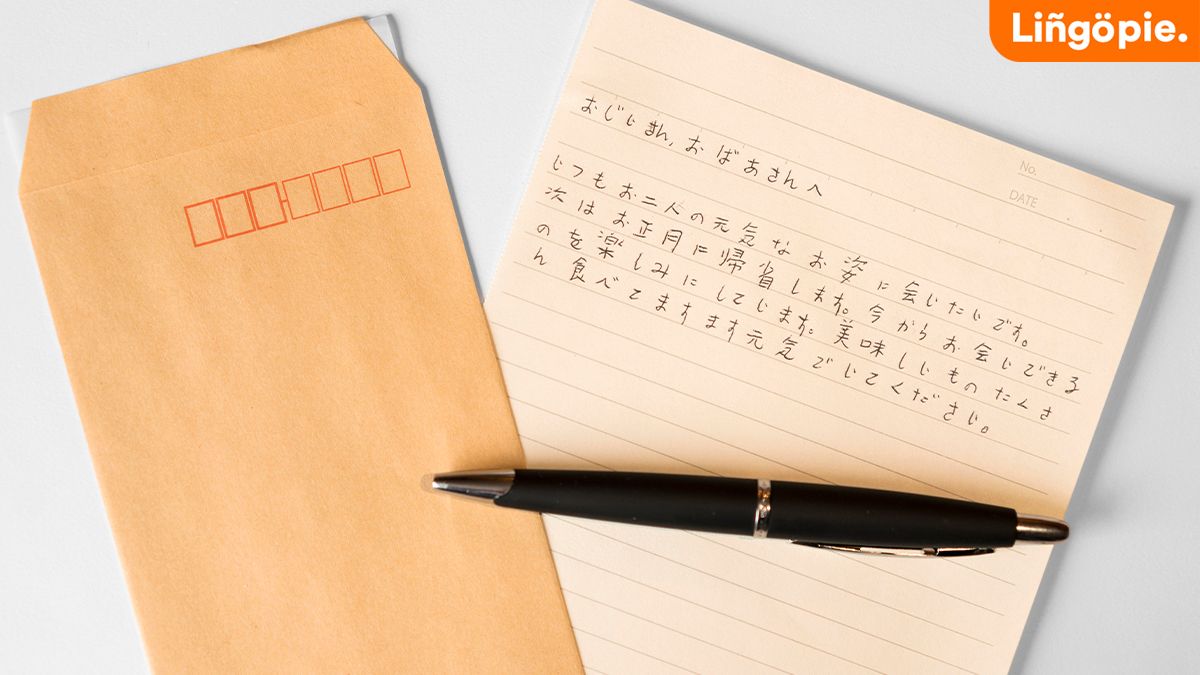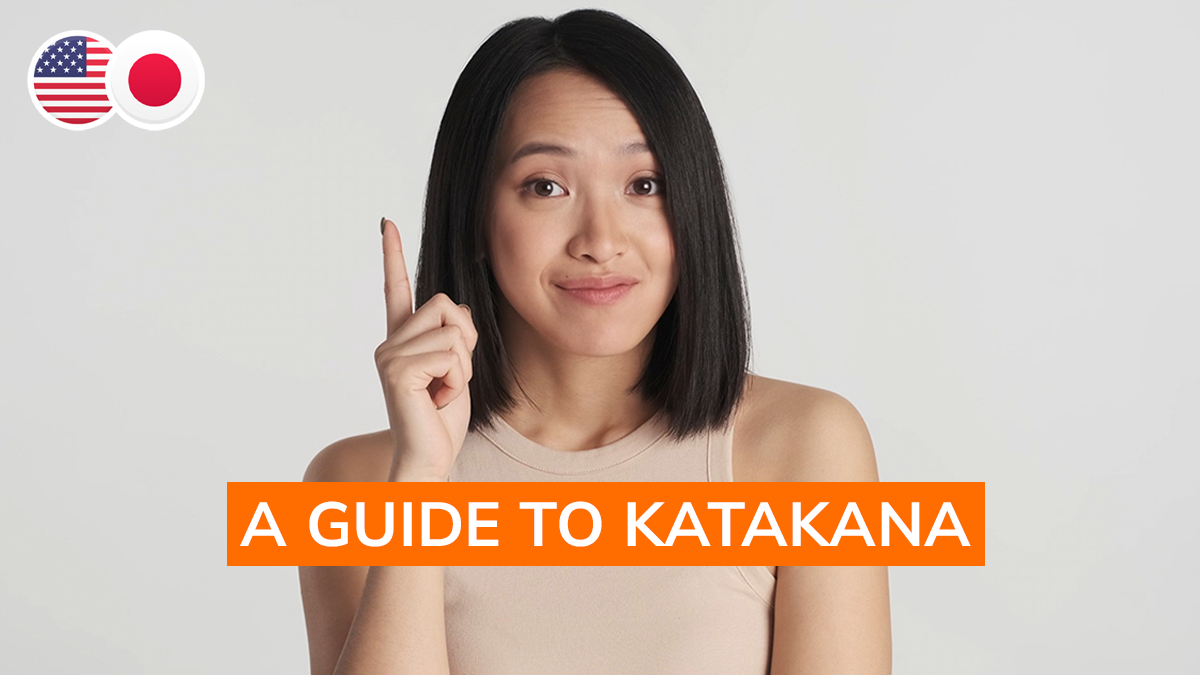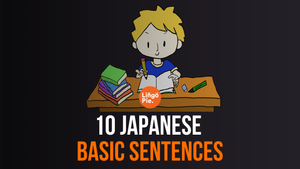This article is part 2 of a 3 part series. The first part will focus on how to learn hiragana, the second katakana, and the third kanji.
So you've been studying hiragana for a while and have gotten the hang of it, and now you're wondering what's next in your journey of studying Japanese?
Well, the most logical thing would be learning to read and write katakana!
Katakana is one of the three Japanese alphabets, the other two being hiragana and kanji.
In this article, we will take you through a brief history of the Japanese writing system, some differences between hiragana and katakana characters, and some useful learnTing strategies.
By the end of this piece, you will have a better idea of how to read and write katakana characters, how they function in the Japanese language in comparison to hiragana and kanji characters, and the best ways to practice.
See also: The best way to learn Japanese
Ready? イキマショー!

What is Katakana? A Quick Background to the Japanese language
So what is katakana, where did it come from, and why is it important in understanding the Japanese language?
Katakana emerged in the 9th century during the Heian period and is thought to have been developed by monks for translating Buddhist texts.
Katakana literally translates to 'fragmentary kana.' This is because katakana characters are derived from components or fragments of more complex Chinese characters.
Like hiragana characters, katakana symbols are phonetic and have a one-to-one relationship with a spoken syllable. These syllables are identical to those that hiragana characters represent, and there is the same number of characters in katakana.
Some Differences Between Hiragana and Katakana Characters
There are some stark differences between katakana and hiragana characters, both in the function that they serve in the Japanese language and the way in which they are written.
While hiragana is used for native Japanese words and grammar particles, katakana can be compared to how English uses italics or capitalization.
Specifically, it is used for the transcription of foreign names and words into Japanese, borrowed words from other languages; to represent onomatopoeia; for technical or scientific terms; for the names of animals, plants, and minerals; and to emphasize things like titles or the names of Japanese companies. We'll go over some examples later on.
Also, unlike hiragana, you will never see katakana used to represent a grammatical particle.
More obviously, you may notice that a katakana character is more angular, sharp, and simple in comparison to its hiragana counterpart. One might even argue that the simplicity of katakana might make it easier to learn than the hiragana version in terms of stroke order.

How to Learn Katakana: The Basic Katakana characters
Once you have learned hiragana, it is very easy to learn katakana. Both alphabets contain 46 characters that represent the same sounds.
For example: キ is the katakana for the hiragana き (ki).
The only difference between these Japanese characters is that the katakana character uses straight lines and one less stroke.
You can think of hiragana characters as written cursive, and katakana characters as writing in print.
Let's take a look at a few more examples:
- セ is the katakana for the hiragana せ (se)
- モ is the katakana for the hiragana も (mo)
- ヤ is the katakana for the hiragana や (ya)
- リ is the katakana for the hiragana り (ri)
However, you should be cautious when learning katakana and pay special attention to learning the correct stroke order. This is because, like hiragana, there are a few similar-looking characters.
For example, let's take a look at the katakana characters シ (shi) and ツ (tsu).
At first glance, these two characters appear to be almost identical. However, when learning katakana, シ (shi) is written with horizontal strokes, while ツ (tsu) is written with vertical strokes.
As with learning hiragana, the first step to learning katakana is by studying and creating your own katakana chart like the one below.
Similar to the hiragana chart, the vowel sounds are located in the furthest right column and organized by consonant sounds from right to left.
Transformations of the Basic Katakana Character
Hiragana and katakana both use the same kinds of transformations to produce different Japanese sounds.
One common anomaly you might see is a small 'tsu' (ッ) in the middle of a word. This is translated into a double consonant in English and depicts a short break in the rhythm of the word.
In katakana, you might usually find the small ッ in foreign words that end with a consonant. An example of this would be the word バッグ (bag), pronounced 'baggu', which would be spelled with double consonants when translated to English.
Additionally, other transformations known as 'dakuten', and 'handakuten' will tweak the original hiragana character to form other sounds.
'Dakuten' are represented with two short strokes in the upper right-hand corner of a character to create new sounds. For example, 'ka' (カ) written with a dakuten becomes 'ga' (ガ).
The unvoiced consonant sound changes to a voiced one, and therefore a 'k' sound will become a 'g' sound. You might notice that the characters for 'za', 'da', and 'ba', are similar to 'sa', 'ta', and 'ha', but with a dakuten tacked on to the end.
Similarly, you might sometimes see a small circle to the right of a character, specifically those characters starting with an 'h' sound. This small circle is called 'handakuten' and will transform all 'h' sounds into plosives, or 'p' sounds. For example, the character ハ (ha) will become パ (pa) with a handakuten added to it.
Two more things: sometimes you may see combination katakana, which will be indicated by a larger katakana character followed by a smaller one.
And, finally, sometimes you may see a katakana character followed by a dash. These horizontal lines indicate that the vowel sound is stretched out for a longer period of time.
Some Examples of Katakana Words
Remember, katakana is used for the transcription of foreign names and words into Japanese, borrowed words from foreign languages; to represent onomatopoeia; for technical or scientific terms; for the names of animals, plants, and minerals; and to emphasize things like titles or the names of Japanese companies.
It is also important to add that this includes ALL foreign languages being translated into Japanese, not just English.
Let's take a look at a few examples you might see in Japan or Japanese media.
Borrowed and Foreign Words
- ビール (biiru) - beer (from Dutch 'bier')
- アルバイト (arubaito) - part-time job (from German 'arbeit')
- カメラ (kamera) - camera
- ホテル (hoteru) - hotel
- パン (pan) - bread (from Portuguese 'pão')
- アイスクリーム (aisukuriimu) - ice cream
- テレビ (terebi) - television, TV
- コンビニ (konbini) - convenience store
- エアコン (eakon) - air conditioning
- スーパー (suupaa) - supermarket
Foreign Names
- カイル (kairu) - Kyle
- クリス (kurisu) - Chris
- ウィリアム (uiriamu) - William
- トム (tomu) - Tom
- アラン (aran) - Alan
- テド (tedo) - Ted
- ローレン (ro-ren) - Lauren
- ブリトニー (buritonii) - Britney
- エミリー (emirii) - Emily
- サラ (sara) - Sarah
Japanese Onomatopoeia
Onomatopoeia actually plays a huge role in the Japanese language. Learning the different kinds of onomatopoeia will not only help you understand forms of media, such as manga and anime but will also help you communicate fluently when speaking Japanese.
There are five kinds of onomatopoeia in Japanese:
- Giseigo - animal and human sounds
- Giongo - actual sounds made by inanimate objects and in nature
- Gitaigo - sounds that describe conditions or states of being
- Giyougo - sounds describing movements or actions
- Gijougo - sounds describing feelings
Let's take a look at a few examples of each!
Giseigo - Animal and Human sounds
All languages have their own way of interpreting nonverbal real sounds. Some of these may sound similar to what you've already heard, and some may be a far cry from what you could have guessed!
- ワンワン (wan wan) - a dog's bark
- ニャン (nyan) - a cat's meow
- ゲロゲロ (gero gero) - a frog's ribbit
- チューチュー (chyuu chyuu) - a mouse's squeak
- コケコッコ (kokekokko) - a rooster's call
Giongo - sounds made by inanimate objects and in nature
These are also real sounds. However, they are ones that wouldn't come out of a person or animal's mouth. For example, the wind in the trees, the river flowing, or someone's phone going off. You might see a lot of these in manga and anime.
- ゴロゴロ (goro goro) - the sound of thunder rumbling
- ザーザー (zaa zaa) - the sound of heavy rain pouring down
- コバコバ (koba koba) - the sound of water bubbling gently
- メラメラ (mera mera) - the sound of suddenly bursting into flames
- タタタタ (ta ta ta ta) - the sound of one's steps while running quickly
gitaigo - sounds that describe conditions or states of being
These onomatopoeias are mimetic to the conditions or state that they describe. You might hear people use these in spoken conversation.
- ムシムシ (mushi mushi) - when it's unpleasantly hot and humid
- ベトベト (beto beto) - when one's skin is sticky with sweat (or blood)
- キラキラ (kira kira) - when something is shining, sparkling, or brilliant
- フアフア (fua fua) - when something is fluffy like a cloud. Think soft, buoyant, puffy things like sheep or a Japanese soufflé pancake
- ドキドキ (doki doki) - when someone's heart is pounding

Giyougo - sounds describing movements or actions
These words describe movements and motions, most commonly when one is walking or traveling from one place to another.
- ウロウロ (uro uro) - when one is wandering aimlessly
- ノロノロ (noro noro) - when one is moving very slowly or sluggishly
- ウトウト (uto uto) - when one is nodding off or falling asleep
- ガクガク (gaku gaku) - when one's joints, like their knees, are shaking
- ブルブル (buru buru) - when one is trembling from fear or anger
Gijougo - sounds describing feelings
These describe emotions and can be found in both manga, and anime, as well as in spoken conversation.
- ワクワク (waku waku) - excited from anticipation or happiness
- モヤモヤ (moya moya) - worrying about the future or wondering what to do
- モジモジ (moji moji) - expresses indecision stemming from embarrassment or shyness
- クヨクヨ (kuyo kuyo) - describes regret or worry about trivial things in the past
- ウキウキ (uki uki) - to be happy or lighthearted
Strategies for Learning Katakana
Once you have learned hiragana, several of the same strategies can be applied to write and read katakana.
All it takes is some dedication, consistency, and practice, practice, practice!
Create Your Own Katakana Chart
Writing out your own chart is the easiest and most basic way to master all the katakana characters.
Just like with learning hiragana, start with the vowels, move on to the basic consonant syllables, then to transformations and combination katakana.
Having your own katakana chart handy will be one of the best resources you can have.
Flash Cards
Once you have familiarized yourself with each katakana character, the next step would be to practice using flash cards. Flash cards are the best way to remember characters and to get some extra practice to write and read katakana.
Start small and write each katakana character on a separate flash card, with the English translation on the other side.
After you've memorized every katakana character, move on to Japanese words.
Just like you did before, write the Japanese words in katakana on one side, and the English words (or foreign words) on the other, practice, and repeat as needed!
Besides writing out physical flashcards, you can also use online tools, like the dynamic flash cards found on Lingopie. This way, you can learn to read and write katakana on your phone anywhere at any time!
Learning Katakana Through Video
Perhaps the best thing you could do to practice your listening and reading is to start watching anime, movies, and TV shows with subtitles.
By engaging with Japanese media, you will be able to hear how Japanese is naturally spoken, and pick up on social cues and colloquialisms you might not find in typical Japanese textbooks.
And if you're going to binge on television for a few hours, you might as well use that time to learn Japanese and teach yourself a thing or two!
A website like Lingopie provides a wide array of Japanese resources to help you learn hiragana and katakana (and eventually kanji characters) while watching Japanese movies and TV shows.
With Lingopie, you can access many popular Japanese anime, movies, and TV shows you might find on Netflix.
However, on top of this, Lingopie also provides online tools like interactive subtitles and flashcards to make learning hiragana and katakana a lot easier and more convenient.
For access to a diverse selection of great Japanese TV shows and films, sign up for Lingopie.
This streaming service offers quality Japanese shows and films that are optimal for practicing both hiragana and katakana.
Common FAQs about Katakana
So, any questions so far? Hold that thought! Here are some commonly asked and answered FAQs. A lot of these questions address two key gripes that come with learning any language: strategy and time.
Hopefully, these will lend some good advice and give you some direction. However, remember that consistency, dedication, and practice are key to learning katakana, Japanese, and any alphabet or language for that matter!
Is katakana easy to learn?
Yes! katakana is a phonetic alphabet, so every character depicts one specific sound. There are 46 characters in total in the katakana script. A little time and practice are all it takes to master Japanese pronunciation.
How can I memorize katakana quickly?
Make a katakana chart. Start with all the basic katakana characters, and then move on to the transformations. This will help you read and write katakana.
Make your own katakana flash cards. This is perhaps the most crucial exercise to learn katakana fast. Start with each katakana character, and then for every new word or phrase you learn.
These two memorization techniques can be applied to hiragana and kanji characters as well.
What is a good way to learn katakana?
Practice writing katakana! Keep a dedicated notebook for vocabulary. Sound out the syllables as you write katakana.
Organize your notebook into three columns: one for the katakana character, one for its hiragana counterpart, and one for the English translations.
Read manga and Japanese books! Japanese graphic novels are a great place to start learning how to read Japanese.
Learning Japanese doesn't have to be boring! Immerse yourself in native TV shows and movies to learn Japanese.
Use Lingopie's interactive subtitles and flashcards for a deeper understanding of hiragana and katakana with English translations.
How long does it take to learn katakana?
Learning the katakana alphabet can take as little as a few hours. After one afternoon of intense memorization, all you need to do is practice reading and writing katakana.
Summing Up: Learning Katakana
Now you are one step closer to being able to speak Japanese!
As we've seen, katakana is a crucial part of learning Japanese. And, considering you have already taken the time to learn hiragana, all you have to do is learn how to write katakana to represent the same sounds.
Each katakana character is a fragment of a more complex kanji character. This will be good to keep in mind when you eventually move on to practice writing and dissecting a kanji character.
We've also seen that katakana plays a different role in Japanese grammar.
Even though each katakana character has the same sound as its hiragana counterpart, we write katakana to express completely different things.
Remember, we only write katakana to express words and names borrowed from a foreign language, for emphasis, for onomatopoeia, and for scientific or technical terms.
Hopefully, now you've been inspired by one or several of the learning strategies we have suggested to help you read and write katakana.
Learning Japanese can be difficult, but it's not impossible when you break it down into easy-to-follow steps!
Be sure to check out the resources on Lingopie to help you learn Japanese faster!






![How To Use Mo (も) Particle In Japanese Grammar [Guide]](/blog/content/images/size/w300/2025/06/How-To-Use-Mo-----Particle-In-Japanese-Grammar.jpg)


